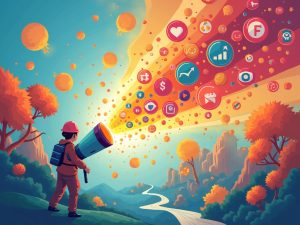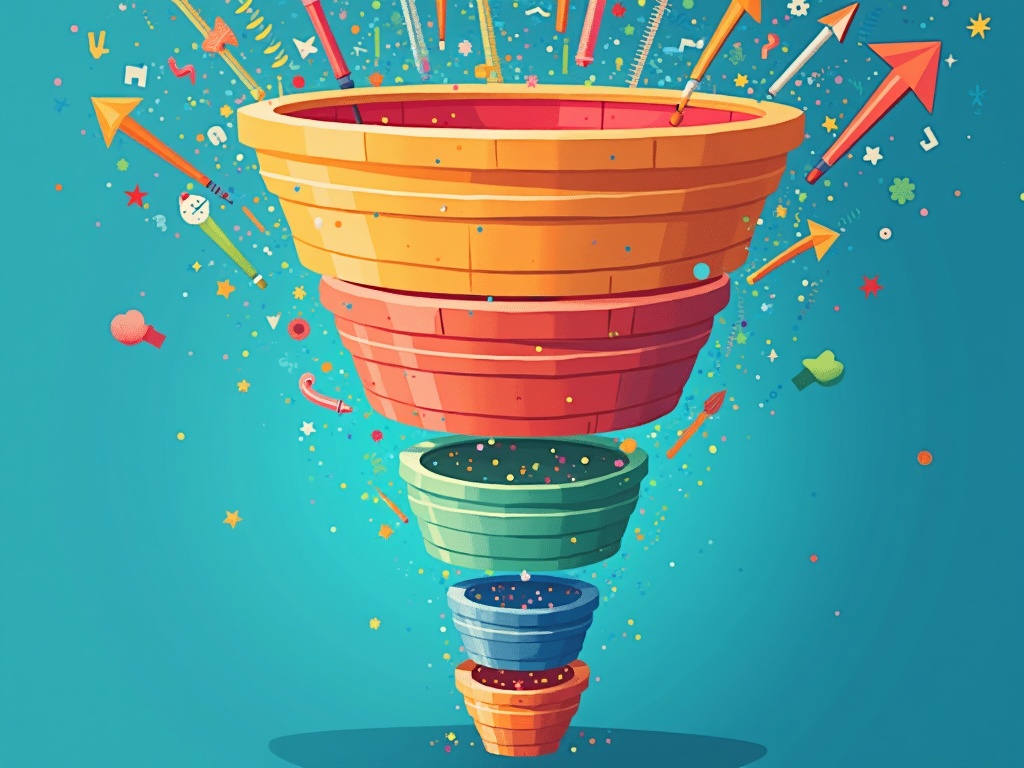How to Create a High-Converting Sales Funnel: A Step-by-Step Guide
Imagine a world where potential customers effortlessly glide through your website, captivated by your message, and eagerly convert into loyal buyers. Sounds idyllic, right? This isn't some marketing fantasy; it's the power of a well-structured, high-converting sales funnel. Forget haphazard marketing efforts and embrace a systematic approach that transforms leads into revenue. Let's dive deep into building a funnel that actually works.
What Exactly is a Sales Funnel (and Why Should You Care?)
A sales funnel, at its core, is a visual representation of the customer journey, from the initial awareness stage to the final purchase. Think of it like a physical funnel: a wide opening at the top, gradually narrowing down to a single point at the bottom. In marketing terms, the top represents all the potential customers who might interact with your brand, while the bottom signifies the paying customers who complete a transaction.
But why should you invest your time and resources in building a sales funnel? Here's why:
- Predictable Revenue: A well-defined funnel allows you to forecast sales based on conversion rates at each stage.
- Targeted Marketing: You can tailor your messaging and content to address the specific needs and concerns of prospects at each stage of the funnel.
- Improved Customer Experience: A smooth and logical flow through the funnel enhances the overall customer journey, fostering trust and loyalty.
- Increased Conversion Rates: By optimizing each stage of the funnel, you can significantly boost the percentage of leads who ultimately become customers.
- Data-Driven Optimization: Tracking metrics at each stage allows you to identify bottlenecks and areas for improvement.
The Classic Sales Funnel Stages: A Detailed Breakdown
While variations exist, the classic sales funnel model typically consists of these four key stages:
1. Awareness (Top of Funnel – TOFU)
This is where potential customers first become aware of your brand, product, or service. They might encounter your content through:
- Blog posts
- Social media ads
- Search engine results
- Referrals
- Infographics
- Guest appearances on podcasts or webinars
Goal: To attract a wide audience and generate initial interest. Focus on providing valuable, informative content that addresses their pain points and establishes you as a thought leader in your industry.
2. Interest (TOFU)
At this stage, prospects are intrigued by your brand and begin to learn more. They might:
- Visit your website
- Download a lead magnet (eBook, checklist, template)
- Subscribe to your email list
- Follow you on social media
- Watch a demo video
Goal: To nurture their interest and position your offering as a viable solution. Provide compelling content that highlights the benefits of your product or service and demonstrates your expertise.
3. Decision (Middle of Funnel – MOFU)
Here, prospects are seriously considering making a purchase. They're weighing their options and comparing you to competitors. They might:
- Read case studies
- Request a quote or proposal
- Participate in a free trial
- Attend a webinar
- Compare pricing plans
Goal: To convince them that your solution is the best choice for their needs. Provide social proof, address their concerns, and offer personalized solutions.
4. Action (Bottom of Funnel – BOFU)
This is the final stage, where prospects take the desired action: making a purchase. They might:
- Add items to their online shopping cart
- Complete a purchase form
- Sign a contract
- Schedule a consultation
Goal: To make the purchase process as smooth and seamless as possible. Provide clear instructions, offer multiple payment options, and provide excellent customer support.
Building Your High-Converting Sales Funnel: A Practical Guide
Now that we understand the stages, let's get practical. Here's a step-by-step guide to creating a sales funnel that drives results:
Step 1: Define Your Target Audience (and Their Pain Points)
Before you build anything, you need to know who you're building it for. Create detailed buyer personas that represent your ideal customers. Consider their demographics, psychographics, motivations, and, most importantly, their pain points. What problems are they trying to solve? What are their biggest frustrations?
Step 2: Craft Compelling Lead Magnets
A lead magnet is a valuable piece of content that you offer in exchange for a prospect's contact information (typically their email address). Think of it as an ethical bribe. Examples include:
- eBooks
- Checklists
- Templates
- Free trials
- Webinar recordings
- Discount codes
Your lead magnet should be highly relevant to your target audience's pain points and offer a quick win.
Step 3: Create Engaging Landing Pages
Your landing page is where prospects land after clicking on an ad, social media post, or email link. It's your opportunity to capture their attention and convince them to take the next step. Key elements of a high-converting landing page include:
- A clear and concise headline
- Compelling copy that highlights the benefits of your offer
- A visually appealing design
- Social proof (testimonials, reviews)
- A strong call to action (CTA)
- Minimal distractions
Step 4: Nurture Leads with Email Marketing
Email marketing is the backbone of a successful sales funnel. Use email to nurture leads, build relationships, and guide them through the funnel. Your email sequence should:
- Welcome new subscribers
- Provide valuable content
- Share case studies and testimonials
- Offer exclusive discounts
- Address common objections
- Lead them towards a purchase
Personalize your emails based on your subscribers' interests and behavior. Use segmentation to send targeted messages to specific groups of people.
Step 5: Optimize Your Sales Page
Your sales page is where you ultimately convince prospects to buy your product or service. It should be persuasive, informative, and easy to navigate. Key elements of a high-converting sales page include:
- A compelling headline
- Detailed product descriptions
- High-quality images and videos
- Social proof
- A clear and concise pricing table
- A strong call to action
- A guarantee or warranty
Step 6: Streamline the Checkout Process
A complicated or confusing checkout process can kill conversions. Make it as easy as possible for customers to complete their purchase. Offer multiple payment options, provide clear instructions, and minimize distractions.
Step 7: Track, Analyze, and Optimize
Building a sales funnel is an ongoing process. You need to track your metrics, analyze your results, and make adjustments as needed. Key metrics to track include:
- Website traffic
- Conversion rates at each stage of the funnel
- Cost per lead
- Customer lifetime value
- Email open rates and click-through rates
Use A/B testing to experiment with different headlines, copy, images, and calls to action. Continuously refine your funnel to improve its performance.
Advanced Sales Funnel Strategies to Boost Conversions
Once you've mastered the basics, you can explore these advanced strategies to take your sales funnel to the next level:
Retargeting Ads
Retargeting ads allow you to show ads to people who have previously visited your website or interacted with your content. This is a powerful way to re-engage prospects who may have abandoned their shopping cart or left your website without making a purchase.
Personalized Marketing
Personalization is key to building strong customer relationships and driving conversions. Use data to personalize your website content, email messages, and product recommendations. Address your customers by name, and tailor your messaging to their specific interests and needs.
Video Marketing
Video is a highly engaging medium that can be used to capture attention, build trust, and drive conversions. Use video to showcase your product, demonstrate its features, and share customer testimonials. Embed videos on your landing pages, in your email messages, and on your social media channels.
Chatbots
Chatbots can provide instant support to your website visitors, answer their questions, and guide them through the sales funnel. Use chatbots to qualify leads, schedule appointments, and provide personalized recommendations.
Tools to Help You Build Your Sales Funnel
Fortunately, you don't have to build your sales funnel from scratch. Numerous tools can help you automate and streamline the process. Here are a few popular options:
- ClickFunnels: A popular all-in-one platform for building sales funnels, landing pages, and membership sites.
- Leadpages: A user-friendly landing page builder with a wide range of templates.
- GetResponse: An email marketing platform with built-in automation features.
- HubSpot: A comprehensive marketing automation platform with tools for sales, marketing, and customer service.
- ConvertKit: An email marketing platform designed for creators and bloggers.
Conclusion: Your Journey to Sales Funnel Mastery
Creating a high-converting sales funnel isn't an overnight endeavor. It's an iterative process that requires careful planning, consistent effort, and a willingness to adapt. But with a clear understanding of your target audience, a compelling offer, and a well-optimized funnel, you can transform your marketing efforts and unlock predictable, sustainable revenue growth. So, roll up your sleeves, get to work, and start building the sales funnel of your dreams. Your future customers (and your bottom line) will thank you for it.

